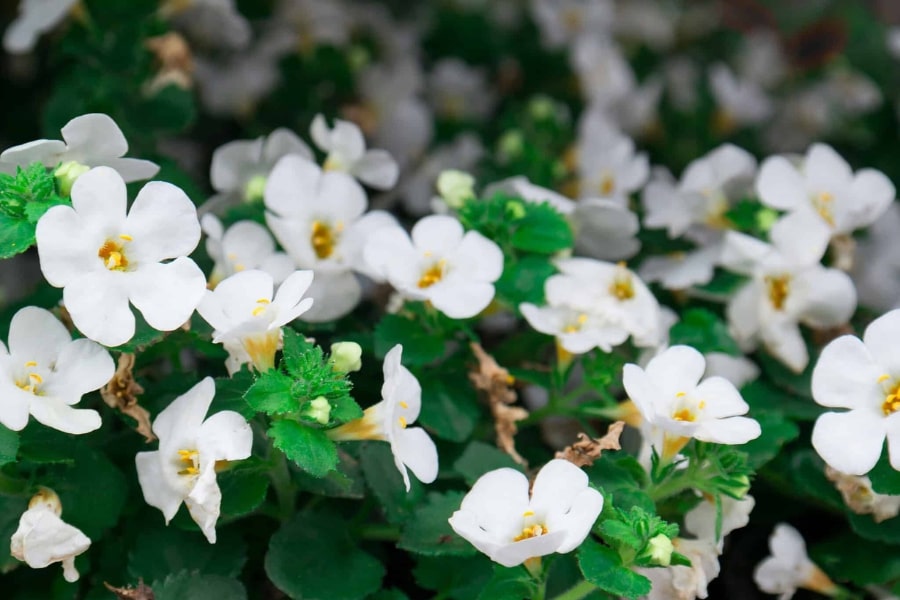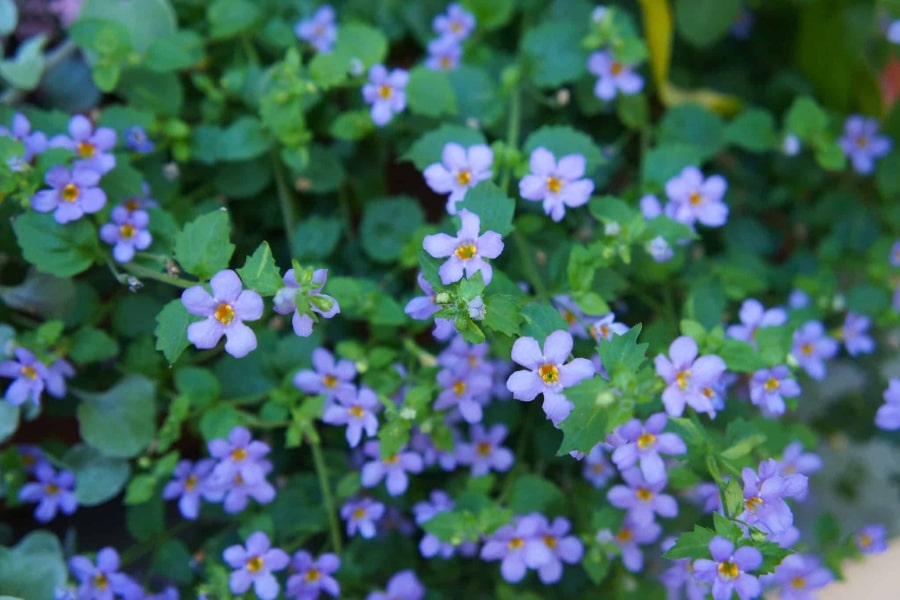Bacopa, less commonly known as Water hyssop, is a plant from the family Plantaginaceae. This plant is native to the wetlands of Asia, Africa, and North and South America. Bacopa is typically a small, creeping plant that grows well in moist soil. It is an ideal choice for hanging baskets and containers as their trailing stems cascade gracefully, creating a lush and cascading effect.

Our Selection of Bacopa
At Martin Garden Center, we grow Bacopa in 4″ containers and hanging baskets that sell out quickly in the Spring. We both grow Bacopa in-house and supplement our supply through trusted regional vendors when needed. We keep the Bacopa table stocked with 2-3 colors throughout the Spring and Summer, though there are rare times when we run out temporarily of one or more colors. For 2026, we are growing several Bacopa varieties, including the Betty, MegaCopa, and Scopia Series.
Here are the varieties we will be growing for 2026:
- Betty Blue
- Betty Pink
- Betty White
- MegaCopa Blue
- MegaCopa Pink
- MegaCopa White
- Scopia Gulliver Blue
- Scopia Gulliver Pink
- Scopia Gulliver White
Growing and Caring for Bacopa
Bacopa thrives in partial shade to full sun, with an emphasis on providing it with bright sunlight. In areas with intense sunlight and high temperatures such as in the Upstate, offering the plant some afternoon shade can help maintain its vibrant appearance. Well-draining soil is essential for Bacopa. Regular watering is also needed to prevent the soil from drying out completely. Keep the soil consistently moist, but avoid overwatering, which can lead to root rot.
Deadheading is generally not necessary with Bacopa, which makes it a very maintenance free plant. However, pruning is required to prevent leggy or straggly growth. At Martin Garden Center, we often refer to Bacopa as a “Thug” as it grows so fast that it can take over very quickly. Pruning can help maintain the plant’s compact and bushy shape. As the growing season progresses, consider trimming any leggy or straggly growth to encourage a denser and more appealing appearance. For our hanging baskets, we recommend pinching back 1-3 legs each week to keep your hanging baskets compact and healthy.
Bacopas are generally not susceptible to pests and diseases with one exception. In the South Carolina Upstate, around late May early June, you may notice that your Bacopa slow down flower production or even stop flowering altogether. This is often caused by bud worms. Butterflies and moths have free roaming capability in the late spring/early summer and they can and will lay eggs on your Bacopa. Those hatched eggs result in small worms that cannot be generally seen by the naked eye (at least not when you are 50 yrs or older) but you will see the damage. Small holes in the petals of your flowers are your first sign. Your solution is a simple spray with BT (Bacillus Thuringensis), an organic pesticide, and within a week, your Bacopa will be floriferous once again.
For a comprehensive guide for pest control in your garden, check out our guide for Preventing and Prosecuting Pests. Or sign up for our in person Bugs Course.
Leaves and Flowers
This plant has small, oval-shaped leaves arranged in opposite pairs along the stem. Bacopa is famous for its petite flowers that come in various shades of white, pink, lavender, and blue. These blossoms are reminiscent of tiny stars and often cover the plant, creating a stunning floral display. Each flower has five petals, giving it a delicate, symmetrical appearance, and they are known for their long-lasting beauty. The blooms attract bees and butterflies and can bloom throughout the year in warm climates.

Uses in the Garden
Bacopa is a versatile trailing plant that adds a delicate, cascading touch to gardens, hanging baskets, and containers. Its small, star-like flowers bloom profusely from Spring through Fall, creating a soft, flowing effect when draped over the edges of pots or spilling from window boxes. In garden beds, Bacopa works beautifully as a low-growing ground cover, filling in spaces between taller plants while adding continuous color. It pairs well with other Annuals and like Petunias and Calibrachoa, enhancing mixed plantings with its lush, trailing habit.
For water gardens and damp areas, Bacopa is an excellent choice due to its preference for consistently moist soil. It can be used along pond edges or in rain gardens, where its trailing growth softens hard edges and blends beautifully with moisture-loving plants. In hanging baskets and container arrangements, Bacopa provides a flowing backdrop for bold, upright flowers, creating a balanced and dynamic display. Regular deadheading isn’t necessary, as Bacopa is self-cleaning, making it an easy-care option for gardeners of all skill levels.

Frequently Asked Questions
Is Bacopa Deer Resistant?
Bacopa is generally considered deer-resistant due to its bitter taste and potentially unpalatable nature to browsing animals. The herb’s natural compounds may deter deer. However, individual deer preferences can vary in times of scarcity; deer might explore a wide range of plants, including those typically considered resistant.
Is Bacopa Toxic to Dogs?
Bacopa is not known to be toxic to dogs. It is generally considered a safe plant to have in gardens and around pets. However, while Bacopa is non-toxic, consuming large amounts of any plant material may cause mild digestive upset in some dogs. If your pet shows any unusual symptoms after eating Bacopa, consult a veterinarian.
